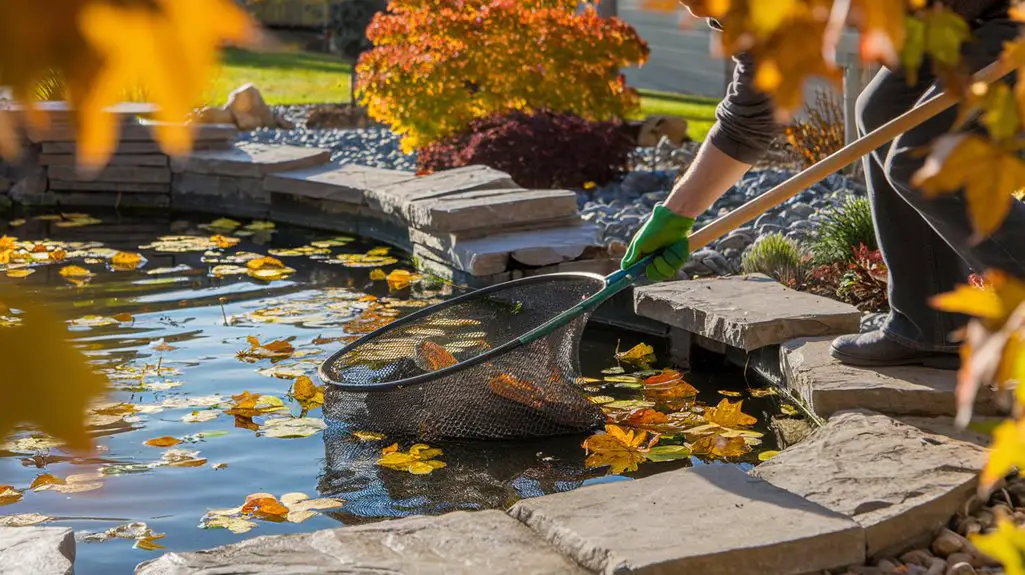Maintaining your backyard water feature throughout the seasons is vital for its health and beauty. In spring, you'll need to clean surfaces and check equipment to kickstart the season. As summer rolls in, monitoring water quality becomes necessary to prevent algae blooms. Fall requires diligent leaf removal to safeguard aquatic life, while winterizing guarantees your feature survives the cold months. Each season presents unique challenges and tasks; let's explore how to effectively manage these changes.
Spring Cleaning and Preparation
As the chill of winter fades, it's essential to prepare your backyard water features for the vibrant season ahead.
Start by removing any debris, like fallen leaves or twigs, that accumulated over the winter months. Scrub the surfaces of your pond or fountain with a soft brush to eliminate algae and stains, ensuring you don't harm any delicate aquatic life.
After cleaning, check your pumps and filters for wear and tear; replacing or repairing them now will save you headaches later.
Consider adding beneficial bacteria to establish a healthy ecosystem. Incorporating charming water features can enhance the overall appeal and tranquility of your outdoor space.
Finally, inspect any surrounding landscaping, trimming back overgrown plants to maintain aesthetics and improve water circulation.
With these steps, your water features will thrive as spring unfolds.
Summer Water Quality Management
With spring cleaning complete, it's time to focus on maintaining water quality as temperatures rise.
Begin by testing your water's pH, aiming for a balanced level between 6.5 and 8.5. Elevated temperatures can lead to algae blooms, so consider using beneficial bacteria or algaecides to keep growth in check.
Regularly skim debris and leaves to prevent decay, which can contaminate your water. Verify that your filtration system is running efficiently; clean or replace filters as needed.
Monitor oxygen levels, especially in smaller features, and consider adding aerators if necessary. Additionally, incorporating rainwater harvesting can provide a sustainable solution to replenish your water feature.
Finally, don't forget to refresh your water periodically—topping off with dechlorinated water helps maintain clarity and quality.
Your water feature deserves the best care to thrive during summer!
Fall Leaf Removal and Debris Control

When autumn arrives, the vibrant colors of fallen leaves can transform your backyard, but they also pose a challenge for maintaining your water feature.
To keep your pond or fountain in top shape, you'll need to actively manage leaf debris. Use a skimmer net or pond vacuum to remove leaves daily; even a few can quickly decay and affect water quality.
Consider placing a leaf net over the water feature to catch falling leaves before they sink. Additionally, keep nearby trees trimmed to minimize leaf litter.
Regular debris control not only protects your water feature's aesthetic but also helps maintain the health of aquatic life. Proper maintenance of water features is essential for ensuring a thriving ecosystem. A little effort now guarantees a thriving environment for next spring.
Winterizing Your Water Feature
To guarantee your water feature survives the harsh winter months, it's crucial to start the winterization process before the first frost. Neglecting this task can lead to expensive repairs or even total loss.
Follow these steps to guarantee a successful winterization:
- Drain the Water: Remove all water from the basin and plumbing lines to prevent freezing and cracking.
- Clean Thoroughly: Scrub the surfaces and remove any remaining debris, algae, or sediment to avoid contamination.
- Protect with Covers: Use a protective cover designed for your specific feature to shield it from snow and ice, preventing damage.
Additionally, consider incorporating DIY backyard pond water features to enhance your pond's aesthetic appeal before winter sets in.
Taking these precautions will help keep your water feature in excellent condition and ready to thrive come spring.
Seasonal Plant Care and Maintenance

As the seasons shift, maintaining the health and aesthetics of your water feature's plants becomes essential for their well-being.
In spring, you'll want to prune back any dead or overgrown foliage to encourage healthy growth. Fertilize with a balanced aquatic plant food to promote lush greenery and blooms.
During summer, regularly check for algae buildup; it can choke out your plants and disrupt the ecosystem.
In fall, cut back perennials and remove any decaying matter to prevent disease. You might consider adding cold-hardy varieties to guarantee winter survival, as best plants around backyard water features can enhance the overall look and health of your setup.
In winter, if you live in a colder climate, you might need to submerge certain plants or bring them indoors to protect them from frost damage.
Pump and Equipment Checks Throughout the Year
While the beauty of your backyard water feature captivates throughout the seasons, regular checks on your pump and equipment are vital to confirm its highest performance.
Neglecting these components can lead to inefficiencies or even failures. Here's what you should inspect:
- Pump Functionality: Verify the pump runs smoothly without unusual noises. Clean any debris that may obstruct water flow.
- Filter Maintenance: Check and clean filters regularly to maintain ideal water quality and flow.
- Electrical Connections: Inspect wiring and connections for wear or corrosion, confirming safety and efficiency in operation. Additionally, ensure you have selected the right pump for your water feature to guarantee optimal performance throughout the year.
Protecting Wildlife During Seasonal Changes
When seasonal changes occur, it's crucial to reflect on the impact on local wildlife that relies on your backyard water feature. As temperatures drop, make sure your pond maintains a warm layer of water beneath the surface—this can provide a refuge for fish and amphibians.
During winter, consider installing a de-icer to prevent complete freezing, allowing birds and other wildlife to access water.
In spring, avoid adding chemicals too early, as this can disrupt the delicate ecosystem awakening around your feature. Additionally, keep an eye out for nesting birds and avoid disturbing their habitats.
Creating a wildlife-friendly garden can enhance the overall health of your backyard ecosystem.
Conclusion
Maintaining your backyard water feature throughout the seasons not only enhances its beauty but also supports the ecosystem it nurtures. Did you know that a well-maintained pond can host over 200 species of aquatic life? By following seasonal care guidelines—from spring cleaning to winterizing—you guarantee a thriving habitat for wildlife and a stunning centerpiece for your yard. Embrace the rhythm of the seasons, and your water feature will reward you with joy and tranquility year after year.




